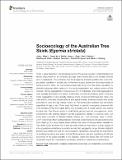Files in this item
Socioecology of the Australian Tree Skink (Egernia striolata)
Item metadata
| dc.contributor.author | Riley, Julia L. | |
| dc.contributor.author | Noble, Daniel W. A. | |
| dc.contributor.author | Stow, Adam J. | |
| dc.contributor.author | Bolton, Peri E. | |
| dc.contributor.author | While, Geoffrey M. | |
| dc.contributor.author | Dennison, Siobhan | |
| dc.contributor.author | Byrne, Richard W. | |
| dc.contributor.author | Whiting, Martin J. | |
| dc.date.accessioned | 2021-12-14T10:30:10Z | |
| dc.date.available | 2021-12-14T10:30:10Z | |
| dc.date.issued | 2021-12-10 | |
| dc.identifier | 277073091 | |
| dc.identifier | 91e72dfb-8d01-4a57-8804-32f1d1548fc8 | |
| dc.identifier | 85121875395 | |
| dc.identifier | 000743035000001 | |
| dc.identifier.citation | Riley , J L , Noble , D W A , Stow , A J , Bolton , P E , While , G M , Dennison , S , Byrne , R W & Whiting , M J 2021 , ' Socioecology of the Australian Tree Skink ( Egernia striolata ) ' , Frontiers in Ecology and Evolution , vol. 9 , 722455 . https://doi.org/10.3389/fevo.2021.722455 | en |
| dc.identifier.issn | 2296-701X | |
| dc.identifier.other | Bibtex: 10.3389/fevo.2021.722455 | |
| dc.identifier.other | ORCID: /0000-0001-9862-9373/work/105006820 | |
| dc.identifier.uri | https://hdl.handle.net/10023/24509 | |
| dc.description | Financial support for this research was provided by The Australian Research Council (ARC DP130102998 grant to MJW and RWB), the Australian Government (Endeavour Fellowship to JLR), the Australian Museum, the Australasian Society for the Study of Animal Behaviour, the Natural Science and Engineering Council of Canada (scholarship to JLR), and Macquarie University (research funding and scholarship to JLR). | en |
| dc.description.abstract | There is great diversity in social behavior across the animal kingdom. Understanding the factors responsible for this diversity can help inform theory about how sociality evolves and is maintained. The Australian Tree Skink (Egernia striolata) exhibits inter- and intra-population variability in sociality and is therefore a good system for informing models of social evolution. Here, we conducted a multi-year study of a Tree Skink population to describe intra-population variation in the social organization and mating system of this species. Skinks aggregated in small groups of 2–5 individuals, and these aggregations were typically associated with shared shelter sites (crevices and hollows within rocks and trees). Aggregations were typically made up of one or more adult females and, often, one male and/or juvenile(s). Social network and spatial overlap analyses showed that social associations were strongly biased toward kin. Tree skinks also exhibited high site fidelity regardless of age or sex. There were high levels of genetic monogamy observed with most females (87%) and males (68%) only breeding with a single partner. Our results indicate that Tree Skinks reside in small family groups and are monogamous, which corresponds with existing research across populations. Similar to previous work, our study area consisted of discrete habitat patches (i.e., rock outcrops, trees, or both), which likely limits offspring dispersal and promotes social tolerance between parents and their offspring. Our study clearly demonstrates that there is intra-population variability in Tree Skink social behavior, but it also provides evidence that there is a high degree of inter-population consistency in sociality across their geographic range. We also highlight promising possible avenues for future research, specifically discussing the importance of studying the nature and extent of Tree Skink parental care and quantifying the fitness outcomes of kin-based sociality in this species, which are topics that will further our understanding of the mechanisms underlying variation in vertebrate social behavior. | |
| dc.format.extent | 15 | |
| dc.format.extent | 4500211 | |
| dc.language.iso | eng | |
| dc.relation.ispartof | Frontiers in Ecology and Evolution | en |
| dc.subject | Squamate reptile | en |
| dc.subject | Lizard | en |
| dc.subject | Mating system | en |
| dc.subject | Monogamy | en |
| dc.subject | Nuclear family | en |
| dc.subject | Sociobiology | en |
| dc.subject | Social organization | en |
| dc.subject | Social structure | en |
| dc.subject | BF Psychology | en |
| dc.subject | DAS | en |
| dc.subject | NIS | en |
| dc.subject.lcc | BF | en |
| dc.title | Socioecology of the Australian Tree Skink (Egernia striolata) | en |
| dc.type | Journal article | en |
| dc.contributor.institution | University of St Andrews. School of Psychology and Neuroscience | en |
| dc.identifier.doi | https://doi.org/10.3389/fevo.2021.722455 | |
| dc.description.status | Peer reviewed | en |
This item appears in the following Collection(s)
Items in the St Andrews Research Repository are protected by copyright, with all rights reserved, unless otherwise indicated.

